Comanche vs Hopi Community Comparison
COMPARE
Comanche
Hopi
Social Comparison
Social Comparison
Comanche
Hopi
1,908
SOCIAL INDEX
16.6/ 100
SOCIAL RATING
283rd/ 347
SOCIAL RANK
1,478
SOCIAL INDEX
12.3/ 100
SOCIAL RATING
306th/ 347
SOCIAL RANK
Hopi Integration in Comanche Communities
The statistical analysis conducted on geographies consisting of 48,136,780 people shows a slight negative correlation between the proportion of Hopi within Comanche communities in the United States with a correlation coefficient (R) of -0.063. On average, for every 1% (one percent) increase in Comanche within a typical geography, there is a decrease of 0.448% in Hopi. To illustrate, in a geography comprising of 100,000 individuals, a rise of 1,000 Comanche corresponds to a decrease of 447.8 Hopi.
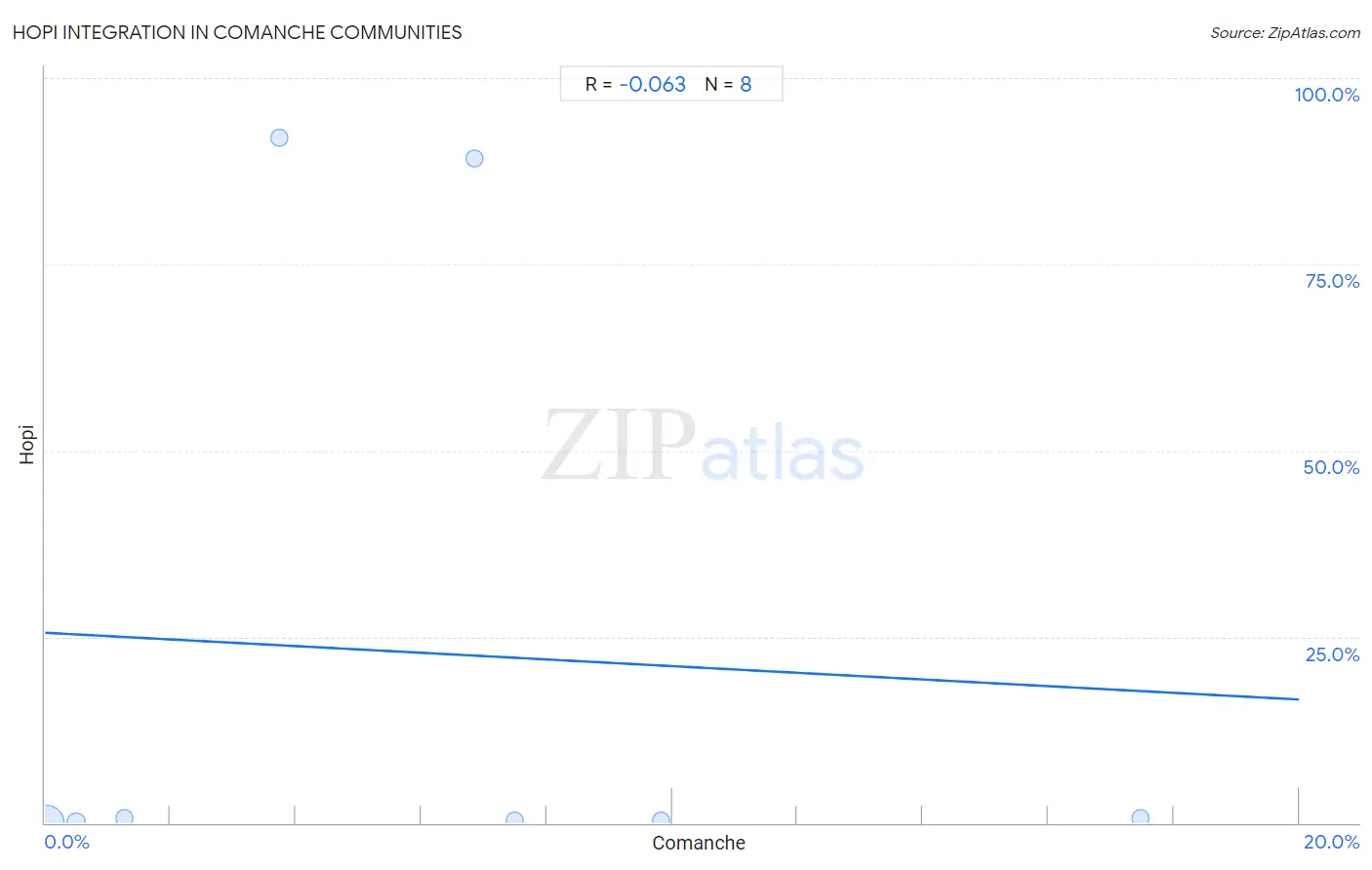
Comanche vs Hopi Income
When considering income, the most significant differences between Comanche and Hopi communities in the United States are seen in wage/income gap (25.0% compared to 20.0%, a difference of 25.1%), per capita income ($38,088 compared to $31,177, a difference of 22.2%), and median family income ($88,556 compared to $77,188, a difference of 14.7%). Conversely, both communities are more comparable in terms of householder income under 25 years ($47,518 compared to $46,978, a difference of 1.1%), median female earnings ($35,661 compared to $33,932, a difference of 5.1%), and householder income over 65 years ($54,922 compared to $50,925, a difference of 7.9%).

| Income Metric | Comanche | Hopi |
| Per Capita Income | Tragic $38,088 | Tragic $31,177 |
| Median Family Income | Tragic $88,556 | Tragic $77,188 |
| Median Household Income | Tragic $73,747 | Tragic $65,043 |
| Median Earnings | Tragic $41,519 | Tragic $36,871 |
| Median Male Earnings | Tragic $48,202 | Tragic $42,060 |
| Median Female Earnings | Tragic $35,661 | Tragic $33,932 |
| Householder Age | Under 25 years | Tragic $47,518 | Tragic $46,978 |
| Householder Age | 25 - 44 years | Tragic $82,152 | Tragic $75,002 |
| Householder Age | 45 - 64 years | Tragic $85,787 | Tragic $75,562 |
| Householder Age | Over 65 years | Tragic $54,922 | Tragic $50,925 |
| Wage/Income Gap | Excellent 25.0% | Exceptional 20.0% |
Comanche vs Hopi Poverty
When considering poverty, the most significant differences between Comanche and Hopi communities in the United States are seen in single male poverty (16.0% compared to 27.5%, a difference of 71.7%), receiving food stamps (13.3% compared to 21.6%, a difference of 62.5%), and male poverty (13.8% compared to 20.8%, a difference of 51.4%). Conversely, both communities are more comparable in terms of single mother poverty (33.9% compared to 34.5%, a difference of 1.6%), single female poverty (25.6% compared to 28.0%, a difference of 9.7%), and married-couple family poverty (6.0% compared to 7.1%, a difference of 18.6%).
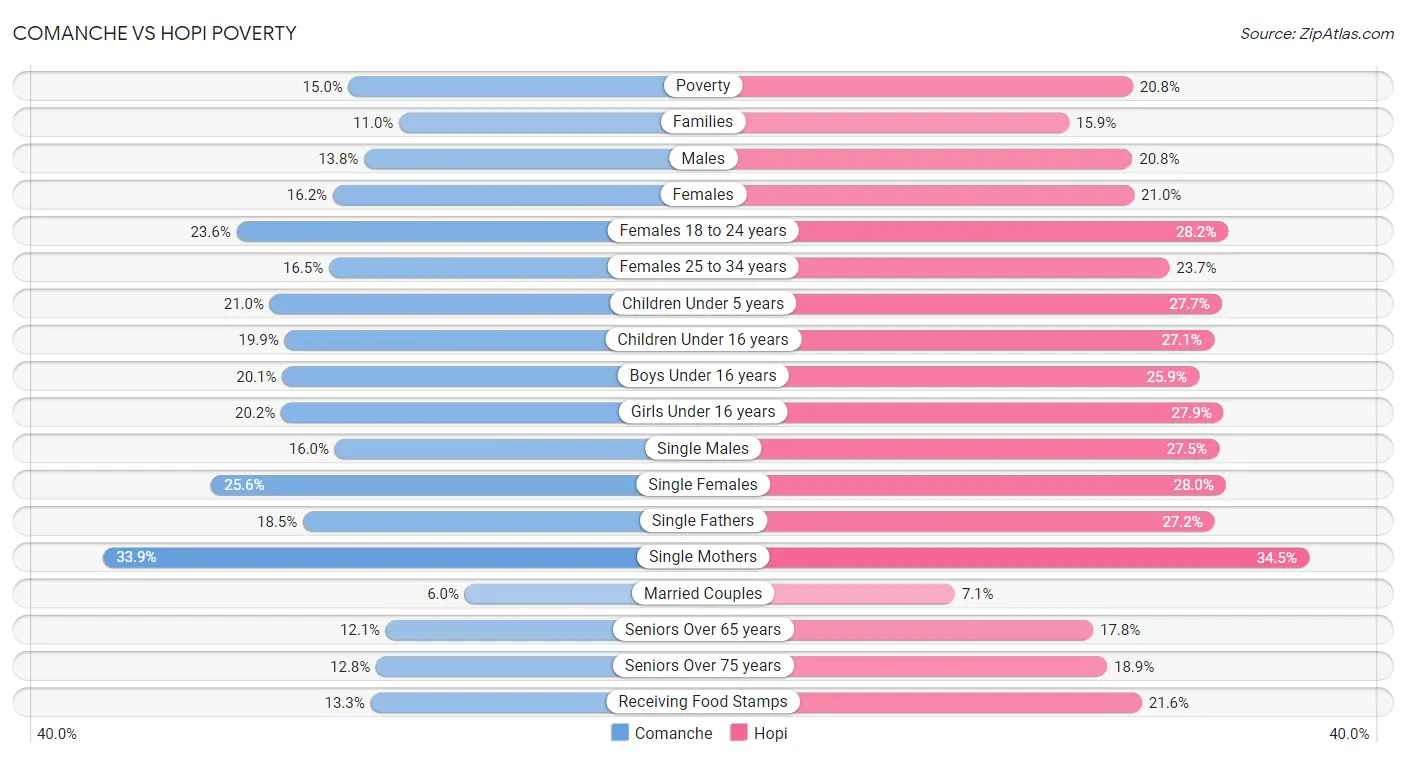
| Poverty Metric | Comanche | Hopi |
| Poverty | Tragic 15.0% | Tragic 20.8% |
| Families | Tragic 11.0% | Tragic 15.9% |
| Males | Tragic 13.8% | Tragic 20.8% |
| Females | Tragic 16.2% | Tragic 21.0% |
| Females 18 to 24 years | Tragic 23.6% | Tragic 28.2% |
| Females 25 to 34 years | Tragic 16.5% | Tragic 23.7% |
| Children Under 5 years | Tragic 21.0% | Tragic 27.7% |
| Children Under 16 years | Tragic 19.9% | Tragic 27.1% |
| Boys Under 16 years | Tragic 20.1% | Tragic 25.9% |
| Girls Under 16 years | Tragic 20.2% | Tragic 27.9% |
| Single Males | Tragic 16.0% | Tragic 27.5% |
| Single Females | Tragic 25.6% | Tragic 28.0% |
| Single Fathers | Tragic 18.5% | Tragic 27.2% |
| Single Mothers | Tragic 33.9% | Tragic 34.5% |
| Married Couples | Tragic 6.0% | Tragic 7.1% |
| Seniors Over 65 years | Tragic 12.1% | Tragic 17.8% |
| Seniors Over 75 years | Tragic 12.8% | Tragic 18.9% |
| Receiving Food Stamps | Tragic 13.3% | Tragic 21.6% |
Comanche vs Hopi Unemployment
When considering unemployment, the most significant differences between Comanche and Hopi communities in the United States are seen in unemployment among women with children under 6 years (8.0% compared to 16.8%, a difference of 108.6%), unemployment among ages 20 to 24 years (10.2% compared to 19.9%, a difference of 95.9%), and unemployment among ages 30 to 34 years (6.3% compared to 11.9%, a difference of 90.5%). Conversely, both communities are more comparable in terms of unemployment among ages 60 to 64 years (5.0% compared to 5.2%, a difference of 2.6%), unemployment among seniors over 75 years (6.7% compared to 6.3%, a difference of 6.4%), and unemployment among seniors over 65 years (4.6% compared to 5.3%, a difference of 15.7%).
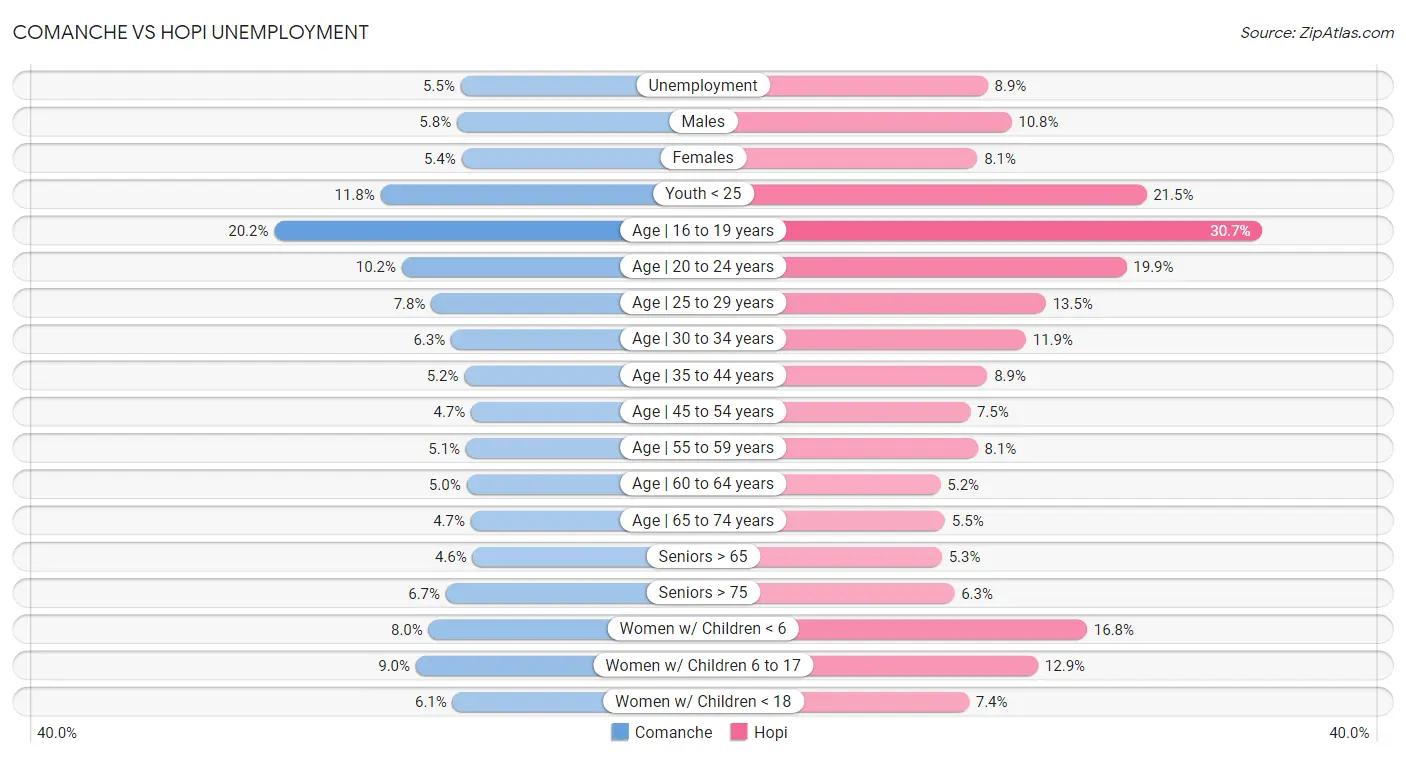
| Unemployment Metric | Comanche | Hopi |
| Unemployment | Tragic 5.5% | Tragic 8.9% |
| Males | Tragic 5.8% | Tragic 10.8% |
| Females | Poor 5.4% | Tragic 8.1% |
| Youth < 25 | Poor 11.8% | Tragic 21.5% |
| Age | 16 to 19 years | Tragic 20.2% | Tragic 30.7% |
| Age | 20 to 24 years | Excellent 10.2% | Tragic 19.9% |
| Age | 25 to 29 years | Tragic 7.8% | Tragic 13.5% |
| Age | 30 to 34 years | Tragic 6.3% | Tragic 11.9% |
| Age | 35 to 44 years | Tragic 5.2% | Tragic 8.9% |
| Age | 45 to 54 years | Tragic 4.7% | Tragic 7.5% |
| Age | 55 to 59 years | Tragic 5.1% | Tragic 8.1% |
| Age | 60 to 64 years | Tragic 5.0% | Tragic 5.2% |
| Age | 65 to 74 years | Exceptional 4.7% | Tragic 5.5% |
| Seniors > 65 | Exceptional 4.6% | Tragic 5.3% |
| Seniors > 75 | Exceptional 6.7% | Exceptional 6.3% |
| Women w/ Children < 6 | Tragic 8.0% | Tragic 16.8% |
| Women w/ Children 6 to 17 | Fair 9.0% | Tragic 12.9% |
| Women w/ Children < 18 | Tragic 6.1% | Tragic 7.4% |
Comanche vs Hopi Labor Participation
When considering labor participation, the most significant differences between Comanche and Hopi communities in the United States are seen in in labor force | age 16-19 (37.7% compared to 31.8%, a difference of 18.5%), in labor force | age 20-24 (75.4% compared to 66.0%, a difference of 14.2%), and in labor force | age > 16 (63.6% compared to 58.4%, a difference of 9.0%). Conversely, both communities are more comparable in terms of in labor force | age 30-34 (82.6% compared to 79.3%, a difference of 4.2%), in labor force | age 45-54 (79.2% compared to 75.0%, a difference of 5.6%), and in labor force | age 35-44 (81.5% compared to 77.0%, a difference of 5.9%).

| Labor Participation Metric | Comanche | Hopi |
| In Labor Force | Age > 16 | Tragic 63.6% | Tragic 58.4% |
| In Labor Force | Age 20-64 | Tragic 77.0% | Tragic 71.7% |
| In Labor Force | Age 16-19 | Exceptional 37.7% | Tragic 31.8% |
| In Labor Force | Age 20-24 | Good 75.4% | Tragic 66.0% |
| In Labor Force | Age 25-29 | Tragic 81.9% | Tragic 76.5% |
| In Labor Force | Age 30-34 | Tragic 82.6% | Tragic 79.3% |
| In Labor Force | Age 35-44 | Tragic 81.5% | Tragic 77.0% |
| In Labor Force | Age 45-54 | Tragic 79.2% | Tragic 75.0% |
Comanche vs Hopi Family Structure
When considering family structure, the most significant differences between Comanche and Hopi communities in the United States are seen in births to unmarried women (36.7% compared to 50.8%, a difference of 38.4%), currently married (45.0% compared to 36.5%, a difference of 23.1%), and married-couple households (44.5% compared to 36.7%, a difference of 21.3%). Conversely, both communities are more comparable in terms of divorced or separated (13.5% compared to 13.2%, a difference of 2.8%), family households (63.5% compared to 65.3%, a difference of 2.8%), and family households with children (27.6% compared to 25.2%, a difference of 9.4%).

| Family Structure Metric | Comanche | Hopi |
| Family Households | Tragic 63.5% | Exceptional 65.3% |
| Family Households with Children | Good 27.6% | Tragic 25.2% |
| Married-couple Households | Tragic 44.5% | Tragic 36.7% |
| Average Family Size | Excellent 3.25 | Exceptional 3.60 |
| Single Father Households | Tragic 2.5% | Tragic 2.8% |
| Single Mother Households | Tragic 7.0% | Tragic 8.5% |
| Currently Married | Tragic 45.0% | Tragic 36.5% |
| Divorced or Separated | Tragic 13.5% | Tragic 13.2% |
| Births to Unmarried Women | Tragic 36.7% | Tragic 50.8% |
Comanche vs Hopi Vehicle Availability
When considering vehicle availability, the most significant differences between Comanche and Hopi communities in the United States are seen in no vehicles in household (10.2% compared to 13.7%, a difference of 34.0%), 3 or more vehicles in household (21.0% compared to 18.2%, a difference of 15.5%), and 2 or more vehicles in household (56.5% compared to 49.0%, a difference of 15.2%). Conversely, both communities are more comparable in terms of 4 or more vehicles in household (6.8% compared to 6.9%, a difference of 1.3%), 1 or more vehicles in household (89.9% compared to 86.4%, a difference of 4.0%), and 2 or more vehicles in household (56.5% compared to 49.0%, a difference of 15.2%).

| Vehicle Availability Metric | Comanche | Hopi |
| No Vehicles Available | Good 10.2% | Tragic 13.7% |
| 1+ Vehicles Available | Good 89.9% | Tragic 86.4% |
| 2+ Vehicles Available | Excellent 56.5% | Tragic 49.0% |
| 3+ Vehicles Available | Exceptional 21.0% | Tragic 18.2% |
| 4+ Vehicles Available | Exceptional 6.8% | Exceptional 6.9% |
Comanche vs Hopi Education Level
When considering education level, the most significant differences between Comanche and Hopi communities in the United States are seen in bachelor's degree (31.9% compared to 25.3%, a difference of 26.1%), associate's degree (39.9% compared to 34.6%, a difference of 15.5%), and master's degree (12.1% compared to 10.9%, a difference of 11.3%). Conversely, both communities are more comparable in terms of 11th grade (91.7% compared to 91.7%, a difference of 0.0%), 4th grade (97.5% compared to 97.7%, a difference of 0.15%), and 5th grade (97.3% compared to 97.5%, a difference of 0.17%).
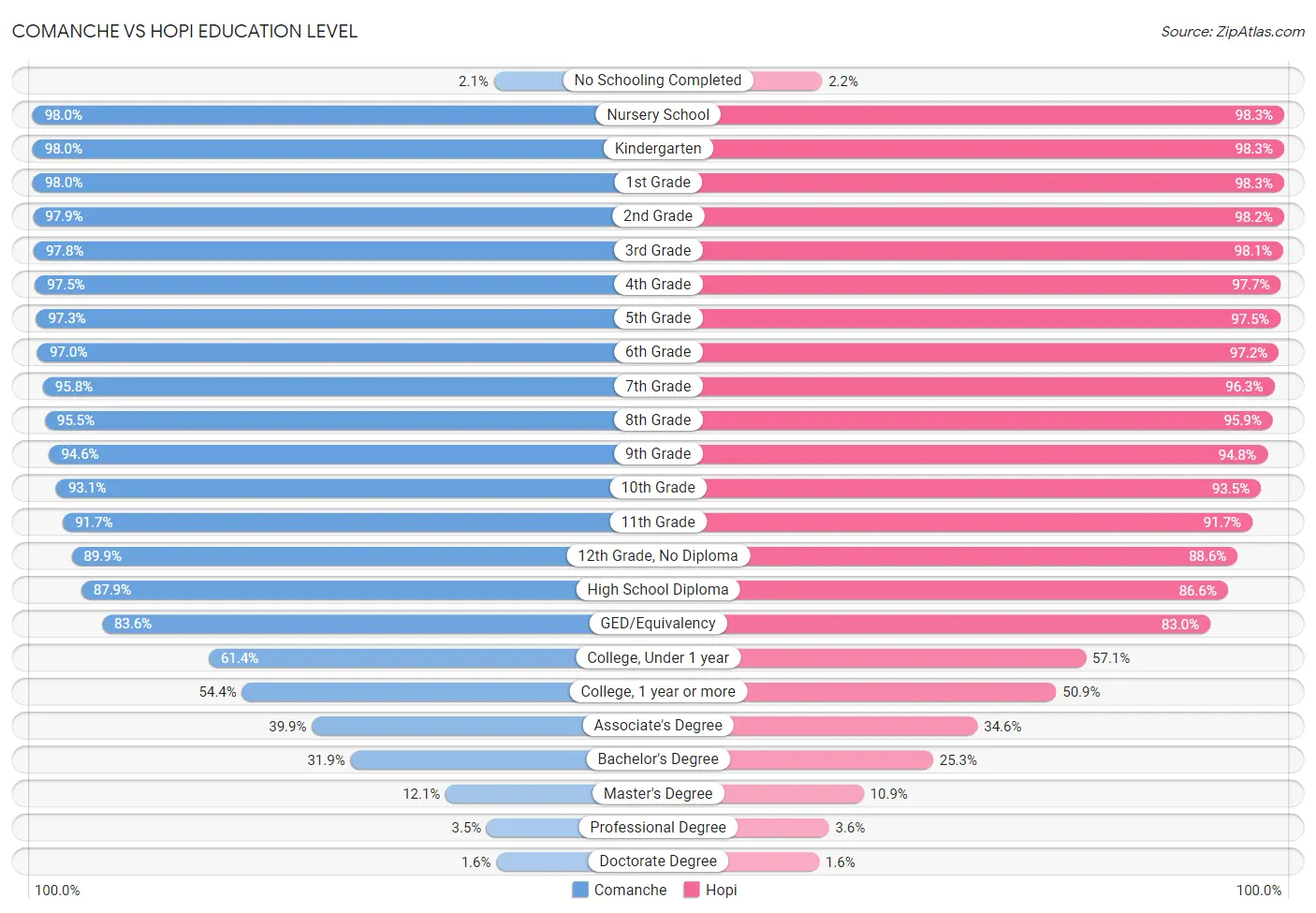
| Education Level Metric | Comanche | Hopi |
| No Schooling Completed | Good 2.1% | Poor 2.2% |
| Nursery School | Good 98.0% | Exceptional 98.3% |
| Kindergarten | Good 98.0% | Exceptional 98.3% |
| 1st Grade | Good 98.0% | Exceptional 98.3% |
| 2nd Grade | Good 97.9% | Exceptional 98.2% |
| 3rd Grade | Average 97.8% | Exceptional 98.1% |
| 4th Grade | Average 97.5% | Excellent 97.7% |
| 5th Grade | Average 97.3% | Good 97.5% |
| 6th Grade | Fair 97.0% | Good 97.2% |
| 7th Grade | Fair 95.8% | Excellent 96.3% |
| 8th Grade | Poor 95.5% | Good 95.9% |
| 9th Grade | Poor 94.6% | Fair 94.8% |
| 10th Grade | Tragic 93.1% | Fair 93.5% |
| 11th Grade | Tragic 91.7% | Tragic 91.7% |
| 12th Grade, No Diploma | Tragic 89.9% | Tragic 88.6% |
| High School Diploma | Tragic 87.9% | Tragic 86.6% |
| GED/Equivalency | Tragic 83.6% | Tragic 83.0% |
| College, Under 1 year | Tragic 61.4% | Tragic 57.1% |
| College, 1 year or more | Tragic 54.4% | Tragic 50.9% |
| Associate's Degree | Tragic 39.9% | Tragic 34.6% |
| Bachelor's Degree | Tragic 31.9% | Tragic 25.3% |
| Master's Degree | Tragic 12.1% | Tragic 10.9% |
| Professional Degree | Tragic 3.5% | Tragic 3.6% |
| Doctorate Degree | Tragic 1.6% | Tragic 1.6% |
Comanche vs Hopi Disability
When considering disability, the most significant differences between Comanche and Hopi communities in the United States are seen in disability age under 5 (1.2% compared to 4.6%, a difference of 272.5%), male disability (14.1% compared to 12.5%, a difference of 12.3%), and disability age 18 to 34 (8.3% compared to 7.5%, a difference of 10.6%). Conversely, both communities are more comparable in terms of hearing disability (4.0% compared to 3.9%, a difference of 0.51%), ambulatory disability (7.5% compared to 7.6%, a difference of 1.1%), and self-care disability (2.9% compared to 2.9%, a difference of 2.2%).
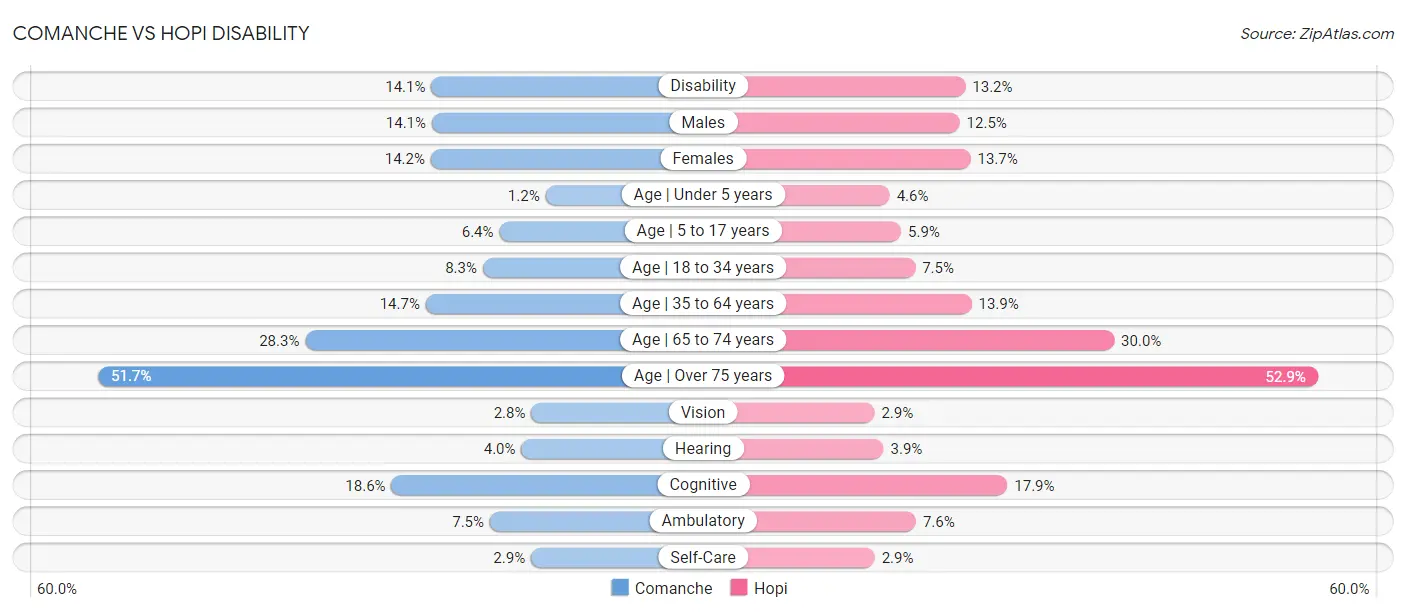
| Disability Metric | Comanche | Hopi |
| Disability | Tragic 14.1% | Tragic 13.2% |
| Males | Tragic 14.1% | Tragic 12.5% |
| Females | Tragic 14.2% | Tragic 13.7% |
| Age | Under 5 years | Average 1.2% | Tragic 4.6% |
| Age | 5 to 17 years | Tragic 6.4% | Tragic 5.9% |
| Age | 18 to 34 years | Tragic 8.3% | Tragic 7.5% |
| Age | 35 to 64 years | Tragic 14.7% | Tragic 13.9% |
| Age | 65 to 74 years | Tragic 28.3% | Tragic 30.0% |
| Age | Over 75 years | Tragic 51.7% | Tragic 52.9% |
| Vision | Tragic 2.8% | Tragic 2.9% |
| Hearing | Tragic 4.0% | Tragic 3.9% |
| Cognitive | Tragic 18.6% | Tragic 17.9% |
| Ambulatory | Tragic 7.5% | Tragic 7.6% |
| Self-Care | Tragic 2.9% | Tragic 2.9% |